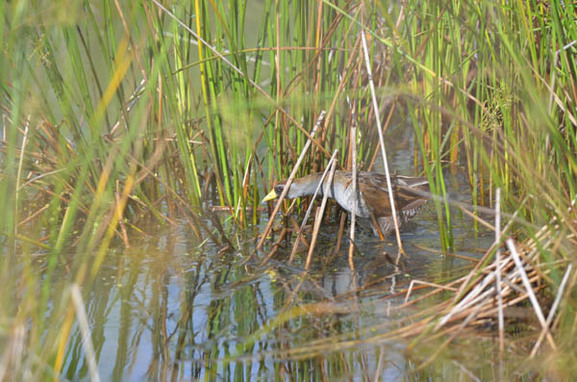 Spring bird migration brings big excitement to Michigan
By HOLLY VAUGHN
Michigan Department of Natural Resources
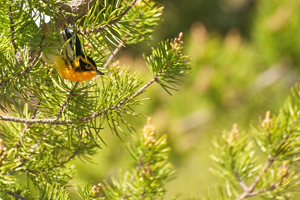 For many birders and other wildlife watchers, the
month of May is just like Christmastime.
The return of Michigan’s migratory birds from
their southern wintering grounds is cause for celebration, and many celebrate
by heading to the fields, forests and wetlands to view these colorful
harbingers of spring.
Many of Michigan’s migratory birds spend the
winter in the tropical areas of Central and South America, where food remains
abundant all winter long.
Many birders considered these neo-tropical migrants, like warblers,
tanagers, buntings and orioles, the
jewels of the treetops. With their bright breeding colors, these are the dazzling
birds that many wait all year to see.
“I love birding in May,” said Andrew Simon, a
Macomb County resident and avid birder. “It’s the peak of migration and marks
the return of my favorite birds – shorebirds and warblers.
“Warblers are so bright and colorful and
always moving, so watching them is always fun and exciting.”
|
 Michigan is located largely within the
Mississippi Flyway, but is on the western edge of the Atlantic Flyway. Flyways
are north-south routes regularly used by large numbers of migrating
birds.
The juxtaposition of the two flyways, paired
with our Great Lakes habitat, makes Michigan an outstanding place to observe a
variety of migratory birds, from waterfowl to hawks to shorebirds to
neo-tropical migrants.
When southerly winds blow in the springtime,
you can expect to see waves of migrants coming north on the winds. Watching the
weather reports can be an effective method to tell whether your next morning of
birding will be a productive one.
“There’s a great website that the Cornell Lab
of Ornithology maintains called BirdCast,” said
Michigan bird conservation coordinator Caleb Putnam. “The site gives you
real-time information about the bird migration that’s occurring in your
backyard. It’s a great tool for planning your birding trips.”
|
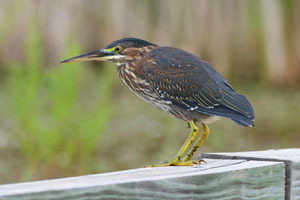 Using the U.S. NEXRAD weather surveillance
radar network, BirdCast can detect large concentrations of migrating birds by
sensing the water in the birds’ bodies. Because many birds migrate at night,
checking the radar at night is a good time to see if birds are headed your way.
“Large circles of blue forming just after
sunset are an indication that the radar is picking up biological targets like
migrating birds, rather than rain, snow or other precipitation,” said Putnam.
If the bird forecast is promising and you’re looking
for a place to find birds in Michigan, there are some great public lands for
you to check out. Michigan’s state parks, along with state game and wildlife areas are a great place to start. There are also several birding trails throughout the
state, each with incredible places to stop and take a look around.
You also might consider heading to one of
Michigan’s Wetland Wonders.
|
Check out a sidebar story on the state’s Wetland Wonders
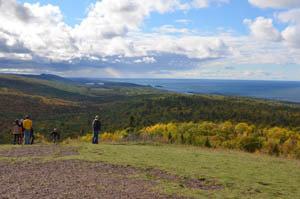 If you
are a beginning birdwatcher, getting out on a birding field trip held by an
Audubon group or other club is a sure way to quickly develop your
identification skills, with knowledgeable trip leaders able to identify bird
songs and calls.
Leaders also can provide a wealth of tips for identifying various species by field
marks, behavioral traits and habitat types.
Beyond
state public land sites for locating migrating spring birds, there are funnel points where
birds congregate in migration, like Whitefish Point in Chippewa County,
Peninsula Point in Delta County or Brockway Mountain in Keweenaw County.
“These
places can provide a stunning morning of birdwatching during spring migration,”
said John Pepin, DNR deputy public information officer. “Males are decked out
in their vibrant bright spring colors and are singing as they set up nesting
territories and try to attract mates.”
Brockway
Mountain, near Copper Harbor, is a fantastic place to see hawk migration.
|
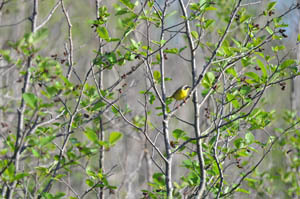 Another
great location to find migrating birds is in your own backyard. Some of the
colorful favorites, like indigo buntings and rose-breasted grosbeaks, are
attracted to sunflower-seed feeders.
Baltimore
orioles, and some other species, are attracted to oranges. Cut an orange in
half and secure it to a tree or post, with a perch nearby. Keep an eye or an
ear to the backyard.
Migrating
birds are also attracted to bird baths.
Sharply marked
beautiful spring warblers can pass through an area in flocks containing several
species.
A good
tip for trying to get a good look at warblers is to locate movement in the tree
branches and look there with your binoculars. Often, the bird will pop into
view from behind leaves or branches.
|
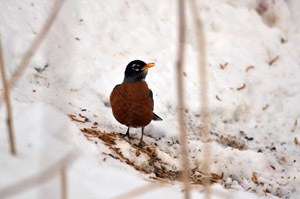 “Male
warblers can be identified by their facial patterns,” Pepin said. “If you focus
on the faces of the males, it will make identifying species easier.”
He said
another good tip is to use range maps in a bird field guide to study which
warblers are likely to be found in your area before you go out to look
for them.
“Looking
up each of these species in a field guide, studying their field marks and
reading about these birds beforehand definitely helps folks identify birds more
easily in the field,” Pepin said. “The same can be said for listening to their
songs.”
The
Cornell Laboratory of Birds “All About Birds” website is a great source for bird identification tips and song
samples.
Whether
you’re watching out the window in your own backyard, visiting a Wetland Wonder
or a state park, or taking a birding hike, you never know what beautiful,
dazzling “presents” you may find under and in the trees.
Get some
family members or friends together for a spring birding outing in Michigan this
month – you too may find that the experience will remind you of a joyous
Christmas morning.
Check out
previous Showcasing the DNR stories at www.michigan.gov/dnrstories. Subscribe to future
stories at www.mi.gov/dnr.
|
/Note to editors: Media contact: John Pepin, 906-226-1352. Accompanying photos are available below for download. Caption information follows. Credit Michigan Department of Natural Resources, unless otherwise noted.
Blackburnian:
The Blackburnian warbler is found high in the tree tops. With its fiery orange
throat, this species is a favorite spring migrant of many birdwatchers.
Brockway:
Brockway Mountain near Copper Harbor in Keweenaw County is a great place to
view spring hawk migration.
Heron:
Green herons can be found on lakes, ponds, rivers and wetlands in Michigan.
Point:
Peninsula Point in Delta County is a great place for spring birding during
migration, along the Lake Michigan coastline.
Robin: An
American robin arrived in Marquette County on spring migration to find snow on
the ground. A homeowner provided a meal worm breakfast.
Sora:
Wetlands provide great habitat for birds, like this sora.
Warbler:
Yellow-rumped warblers are among the early spring migrants to return to
Michigan.
Yellowthroat:
Common yellowthroats are warblers found in wetland areas.
Sidebar
Images:
Birdwatcher:
A birdwatcher enjoys the view at Fish Point State Wildlife Area in Tuscola County.
Dunlin:
Shorebirds like this dunlin are common at Pointe Mouillee in Monroe and Wayne counties./
|